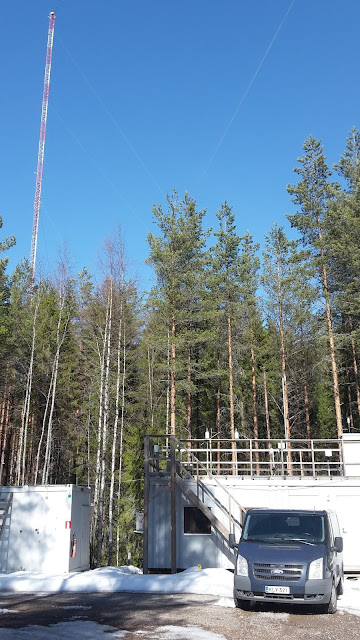Another spring, another start of a measurement campaign
It is a yearly routine: the temperature slowly increase and there is more light. It is then time to transport our instrumentation to the field! After our measurement campaign in Lapland last year (I wrote about it previously here and here), this year we are back at the SMEAR II station in Hyytiälä in southern Finland.
The SMEAR II station has become a hotspot for atmospheric sciences starting from the mid-1990s. The Finnish Meteorological Institute performs routine measurements there and research is also conducted at the site on Biogenic Volatile Organic Compounds (BVOCs) and other topics related to air quality.We performed an OH reactivity study at this site in 2016 (which is currently under review for Atmospheric Chemistry and Physics, see the open discussion), which was building on previous studies by Sinha et al. (2010) and Nölscher et al. (2012). Then, we extended the study period to include the spring and not only summer as the mentioned earlier studies. One result of this study that intrigued me was the observation of large OH reactivity peaks during the days around the time when the soil was thawing. There is currently still about 30cm of snow at SMEAR II (in patches) and the soil is still frozen (according to the data available from SmartSMEAR). I am personally very eager to see if we can capture again these reactivity peaks. Our colleagues from the University of Helsinki are operating a mass spectrometer that should be able to capture not only VOCs, but also oxygenated VOCs (and possibly other compounds). Will these show peaks at the same time as OH reactivity? Let's see!
Figure 1. Left: FMI van in front of FMI container in the "container village" at SMEAR II (Hyytiälä) with the station mast visible in the background. Centre: View of the back of the container with melting snow and the forest edge. Right: FMI instrument to measure total OH reactivity with the Comparative Reactivity Method. (Pictures: Arnaud Praplan, CC-BY-4.0)
Later in spring and summer we will measure further the emissions from various tree species to build on similar measurements that I will present next week at the European Geophysical Union General Assembly in Vienna (poster presentation). In this case as well we will expand the measurements with instrumentation to investigate aerosol formation potentials from the emissions and ozone reactivity.



Comments
Post a Comment